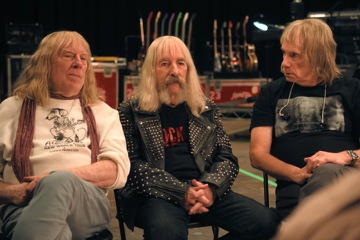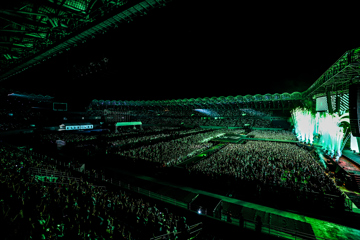Live Review: Jeff Mills, Matt Radovich, ACM
"Mills is techno's Starman, journeying back from the future into his own mythology."
The Detroit electronic auteur Jeff Mills has long challenged perceptions of 'techno' – approaching it as an intellectual as much as a musical movement. Significantly, he's defied the divide between subculture and arts institution. And Mills has done this consistently even in Melbourne, one of (Detroit) techno's satellite cities. Indeed, the conceptual DJ/producer previewed his innovative score to Buster Keaton's silent comedy film Three Ages at ACMI in 2004. And Mills has twice presented an orchestral concert in Melbourne, most recently in 2016 with Derrick May and the Melbourne Symphony Orchestra. In 2018, Mills is a special guest at Melbourne Music Week – and returning to ACMI both for a Cinemix live rendition of his Woman In The Moon soundtrack (on Friday, MMW's opening night) and tonight's sold-out hybrid audiovisual show, The Trip, with digital artist Kit Webster.
If, in Melbourne, techno has traditionally belonged to clubs and warehouses, then it's now equally at home in the art space – and Mills draws a cross-generational audience. Scheduled early is ACM (aka Andy Muscat), below the main platform. The local stalwart delivers a panoramic, yet driving, live set, climaxing with a volcanic eruption of lasered acid techno. Next is the maverick DJ Matt Radovich, founder of the Melbourne Techno Collective, on stage. A Stable Music event regular, he's not about to change, or compromise, his modus operandi with pounding beats (broken up by the occasional diva vocal). Radovich might be at an underground rave.
Jeff Mills comes on at midnight, his console to the side of an epic screen. Touted as a "performance piece", The Trip is purportedly inspired by the American's fascination with outer space. But, Mills being no linear thinker, that becomes a rumination on nostalgia, temporality, possibility, transcendence and existentialism. Mills' sonic aesthetic is less industrial minimalism than cerebral, and abstract, techno, with him actually venturing into classical. And he is silhouetted starkly against Webster's plundered cinematic imagery of astronauts – plus heroes, villains and ambiguous damsels.
An hour later, and Mills walks off in slow motion – eventually reappearing on the screen himself. In fact, the composer plays live from backstage in an area covered in foil, crouching at his keyboards. Years before the strange hologram trend in live performances began, with Snoop Dogg and Dr Dre joined by a ghostly Tupac Shakur at 2012's Coachella, Mills (who, coincidentally, launched his career in Motor City as the hip hop turntablist The Wizard) speculated about touring the world in this form himself. The Trip's offstage experiment could just be a precursor to such a postmodern Millsian enterprise. Beamed on screen with mesmerising hallucinogenic filters, Mills' live sequence also resembles a '90s dance music video. Most of all, it represents a nod to the irony that so many attendees are already viewing The Trip through their phones.
Last, Mills resurfaces for a more familiar DJ set. The dramatic conclusion to The Trip's suite evokes Mills' Purpose Maker mode, complete with 909 drum machine solo-ing. Mills is techno's Starman, journeying back from the future into his own mythology.







